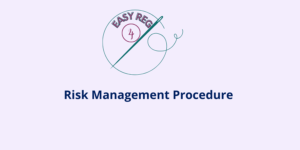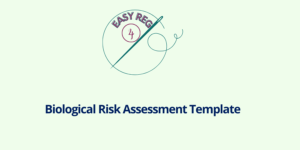Biocompatibility evaluation according to ISO 10993-1 and the related biological risk assessment is one of the most important validation activities for medical device. It is an important process during the design of the device that has a fundamental impact in the regulatory clearance or approval of the device by regulatory agencies or notified bodies.
Biocompatibility evaluation for medical devices is a very broad topic which can be faced from different angles. The goal of this article is to provide a high-level overview of approach that can be used for the validation of medical devices from biocompatibility point of view.
The topic that will be covered in this post is focused on the Risk Management Approaches for Biocompatibility Evaulation.
FDA recently published an extensive guidelines in the interpretation of International Standard ISO 10993-1, “Biological evaluation of medical devices – Part 1: Evaluation and testing within a risk management process” . This guideline shall be used to support pre-market approval submission for the part related of biocompatibility evaluation. The guidance well explained the application of the risk management process for biocompatibility evaluation which is one of the pillar of ISO-related regulation for biocompatibility evaluations of medical devices.
Risk Management Approaches for Biocompatibility Evaluation
Based on ISO 10993-1, the BRA is the process of evaluating the device and the related manufacturing from biological risks point of view. It can be considered a part of the risk management process.
Biological evaluation of medical devices shall begin with the so-called Biological Risk Assessment (BRA). This basically shall include an assessment of the device, including materials, manufacturing process, intended use and frequency and duration of exposure. It is very important the risk assessment is performed on the finished device, which is the entity that will be cleared by the agency (FDA).
Following ISO 10993-1, the biocompatibility testing strictly depends from the type of the device, from the type of contact between the device and the patient and the duration of this contact.
Going more in details in the risk assessment process, the following items shall be taken in consideration:
• Materials of the devices
• Processing of these materials
• Manufacturing process, including any residue that might come in contact with the patient or user
• The intended use and user population
The exposure duration should consider which material components of the device have direct or indirect contact with tissue, and if the exposure would be a onetime exposure, a constant exposure over time. It is also possible to have an intermittent exposure over time that could have a cumulative effect.
In the framework of risk assessment for biocompatibility testing, it is essential to evaluate the physical characteristics of the materials/devices that might trigger an unwanted response.
Based on ISO 10993-1, this can include, for example, surface geometry, presence of particles on the surface of the device, etc. Sources of information on potential biocompatibility risks can include, for example, the previous experience of a manufacturer with the same material(s) or devices, preferably in the same or similar anatomical location; reported experience from other manufacturers using the same material in the same or similar anatomical location; literature search and information provided by the material supplier. It also possible to use postmarket surveillance data on same/similar device to identify specific risks useful to perform the biological risk assessment.
It is very useful that the manufacturer compiles a master file for materials and components that includes the processing for the material/component and all the biological testing that have already been performed.
ISO 10993-1 states that a chemical analysis of the materials used in a device in its final finished form can be useful to gather further information on the biological risks associated to the device. Chemical analysis can be particularly helpful to demonstrate that chemical toxicity testing from a previously cleared or approved medical device is relevant to a device under review by the FDA.
-
 Risk Management Plan Template€64,00
Risk Management Plan Template€64,00 -
 Risk Management Procedure€64,00
Risk Management Procedure€64,00
ISO 10993-1 and Approaches for Risk Mitigations
According to ISO 10993-1, there are different approaches that could be used to mitigate a biological risk for a finished medical device.
1) Literature and other publicly available information:
Manufacturers could review all the available toxicity information and other publicly available information to determine the toxicity risks for the materials used to manufacture their medical device. It is very important that manufacturers when considering available literature with respect to specific device materials, perform an evaluation whether the collected information is relevant in light of the manufacturing of the medical device.
2. Clinical experience
Clinical experience shall be considered by the manufacturer in the overall benefit-risk profile for the device ; in this contest it is necessary to evaluate whether the totality of the data available for the device may inform whether more testing is needed, or if any testing is needed at all.
Generally, clinical studies are not sufficiently sensitive to identify biocompatibility concerns. Clinical symptoms that are related to the presence of a non-biocompatible material may not be identifiable, or may result in symptoms that are indistinguishable from the disease state for which the device is used.
3. Animal study experience
Sometimes, data coming from an in vivo animal study of the medical device in its final finished form may be used in lieu of some biocompatibility tests.
It is important that the biocompatibility study in animal model include assessments for biocompatibility endpoints in order to be used for biocompatibility evaluation of the specific medical device. These studies should evaluate the biological response to the test article implanted in a clinically relevant implantation site.
4. Medical device standards
Standards specific to a well particular medical device type or material can be helpful to inform a risk assessment. It is necessary to evaluate the extent to which the standard could be utilized. This can be dependent on the specificity of the standard and/or the specific material.
5. Devices previously reviewed by FDA
Experience with medical device materials previously reviewed by FDA (e.g., in previous generation devices, PMA- approved devices, predicate devices) can also be taken in consideration as part of a risk assessment.
According to the agency, this information may be more informative when the manufacturers are able to leverage their own experience, rather than that from another manufacturer or supplier. This is because for the manufacturing process of other suppliers or manufacturers is often unknown.
Biological Risk Assessment Template
QualityMedDev provides a Biological Risk Assessment Template, a document that will definitely support and facilitate the documentation related to theological safety of medical devices. This document defines the strategy for biological risk assessment, which is, in other words, the application of ISO 14971 requirements into the evaluation of the biological safety of medical devices.
Conclusions
In conclusion, the biocompatibility evaluation according to ISO 10993-1 and the related Biological Risk Assessment of medical devices is en essential step nowadays for quality and regulatory experts and in general for the quality management system.
Subscribe to 4EasyReg Newsletter
4EasyReg is an online platform dedicated to Quality & Regulatory matters within the medical device industry. Have a look to all the services that we provide: we are very transparent in the pricing associated to these consulting services.
Within our WebShop, a wide range of procedures, templates, checklists are available, all of them focused on regulatory topics for medical device compliance to applicable regulations. Within the webshop, a dedicated section related to cybersecurity and compliance to ISO 27001 for medical device organizations is also present.
As one of the leading online platforms in the medical device sector, 4EasyReg offers extensive support for regulatory compliance. Our services cover a wide range of topics, from EU MDR & IVDR to ISO 13485, encompassing risk management, biocompatibility, usability, software verification and validation, and assistance in preparing technical documentation for MDR compliance.
Do not hesitate to subscribe to our Newsletter!

